Enjoyed this post?
Be sure to subscribe to the nopAccelerate newsletter and get regular updates about awesome posts just like this one and more!
Imagine this: you’ve spent months perfecting your product, building a marketing strategy, and lining up distribution partners. Launch day arrives, and suddenly your ecommerce platform becomes the most important business decision you’ve made.
Your store isn’t just a website; it’s the engine driving sales, customer experience, data, and growth. The wrong platform can slow you down with hidden fees, poor integrations, or limits on customization. The right one becomes a scalable foundation for years to come.
That’s why ecommerce platform comparisons are so critical in 2025. With dozens of solutions available, making the right call means looking beyond the buzzwords and evaluating how platforms perform in real-world business scenarios.
In this guide, we’ll explore six leading platforms — nopCommerce, Shopify, WooCommerce, Magento (Adobe Commerce), Wix, and Squarespace and uncover their pros, cons, pricing, and best-fit business cases.
Ecommerce isn’t new. What’s new is how fast it’s evolving. Businesses no longer ask “Should we sell online?” — the question is “How do we scale, differentiate, and compete globally?”
Global ecommerce revenue is forecasted to reach nearly US $5 trillion by 2030, growing at 6.3% annually between 2025 and 2030 (Statista 2025).
Platforms now compete not only on speed-to-launch but also on security, compliance, and integration with ERP/CRM systems.
When comparing ecommerce platforms, there are five key factors businesses consistently evaluate:
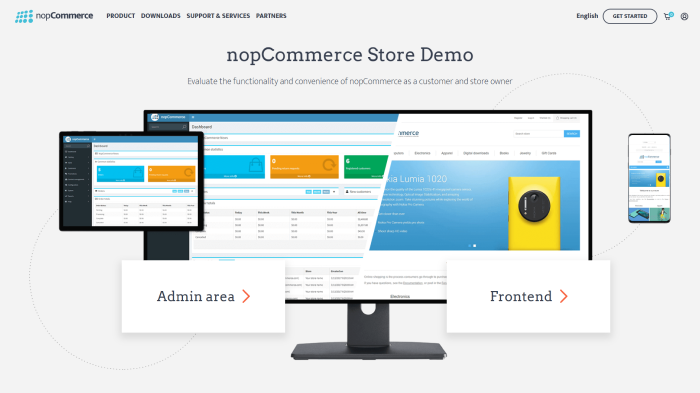
nopCommerce isn’t as widely hyped as Shopify or WooCommerce, but it’s quietly powering 60,000+ live stores, with over 1.5 million downloads in the last 15 years. Built on ASP.NET Core, it’s trusted by brands like BMW, Microsoft, Herbalife, The North Face, Volvo, and Harman Kardon.
nopCommerce enterprise-grade, yet absolutely free and open-source.
Pricing: Free license. Costs are hosting + development (in-house or via nopCommerce partners)
If you’d like a deeper breakdown of who nopCommerce is best suited for, check out our detailed guide: nopCommerce E-commerce Platform: 2025 Guide to Who It’s Ideal For
A sustainable fashion brand struggled with slow site speed, weak search, and limited multilingual support on its old webshop. By moving to nopCommerce, they gained faster performance, better branding flexibility, and easy multi-language management, boosting user experience and sales.
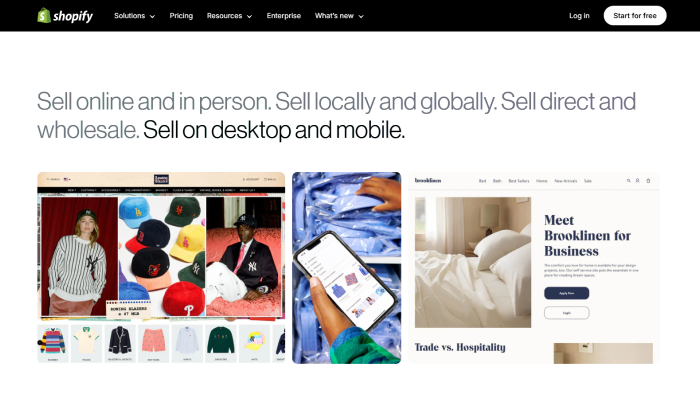
If there’s one name synonymous with ecommerce, it’s Shopify. Powering over 4 million stores worldwide, Shopify is beloved for its ease of use and fast setup. Its SaaS-based model makes it ideal for entrepreneurs and small businesses who want to start selling without worrying about hosting or infrastructure.
Pricing: Monthly Price (USD): Starter – $5/month, Basic – $39/month, Grow – $105/month, Advanced – $399/month, Plus – $2,300–$2,500/month
Shopify is ideal for startups and entrepreneurs who want a fast go-to-market solution without worrying about infrastructure.
An international lifestyle brand struggled with fragmented systems and inconsistent customer experiences. By adopting Shopify’s unified commerce, they gained real-time data, streamlined omnichannel sales, and achieved 40% customer growth with higher in-store average order values.
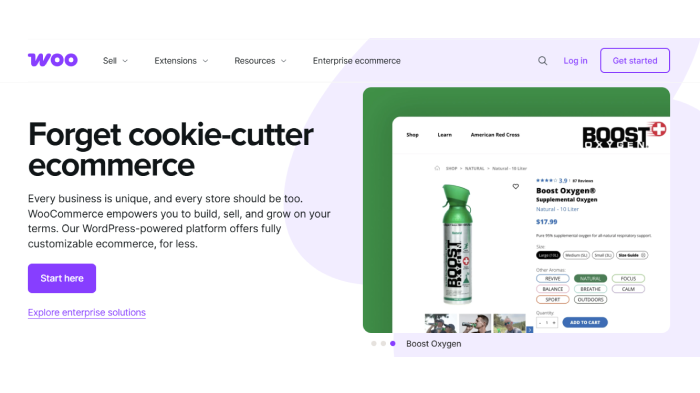
WooCommerce is the natural choice for WordPress-powered businesses. As a free plugin with a massive ecosystem, it transforms a content-first site into a flexible ecommerce store. It’s especially popular among SMBs and content-driven brands that value SEO and control.
Pricing: Total costs typically range from $1,821 on the low end to $67,791+ on the high end, depending on hosting, themes, development, extensions, and marketing.
Perfect for content-first brands, bloggers, and SMBs who want ecommerce directly integrated with their WordPress sites.
An oral care company managing nearly a million customers used WooCommerce to improve flexibility and integrations. The platform helped automate marketing and streamline operations, resulting in 47% revenue growth and a stronger repeat customer base.

Magento, now Adobe Commerce, has long been recognized as an enterprise-grade ecommerce powerhouse. It offers virtually unlimited customization and advanced B2B features but requires significant investment and technical expertise.
Pricing: Licensing ranges from $22k–$125k/year. Development and implementation add significantly, often requiring large budgets for enterprise readiness.
Large enterprises with big dev teams and multi-country operations use Magento for its robust extensibility.
Ulta Beauty, with 44M+ loyalty members, uses Adobe’s Real-Time CDP and Journey Optimizer to power personalized experiences across web, app, and stores. The platform strengthened omnichannel engagement, lifted loyalty-driven sales, and enabled real-time, data-driven personalization at scale.
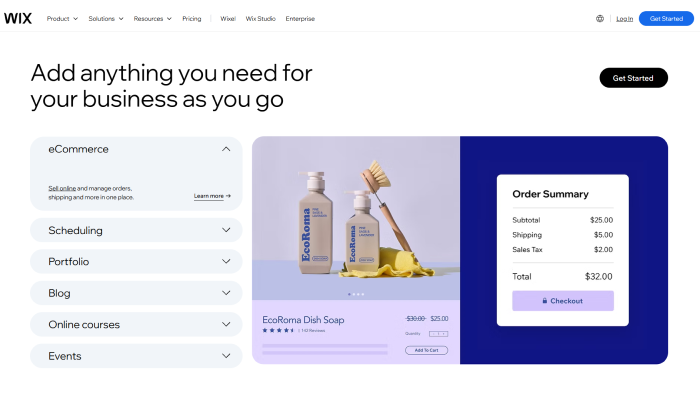
Wix started as a website builder but has grown into a user-friendly ecommerce solution. It’s best suited for small businesses, solopreneurs, and creatives who prioritize design and ease over complex ecommerce features.
Pricing: Wix 2025 plans cost $0 (Free), $17 (Light), $29 (Core), $36 (Business), and $159 (Business Elite) per month, billed annually.
Great for solopreneurs, creatives, or service businesses adding a small shop section.
An SEO agency migrated to Wix to escape WordPress maintenance issues. The result: faster load times, improved Core Web Vitals, zero traffic loss during migration, and stronger search rankings thanks to Wix’s built-in SEO and performance tools.
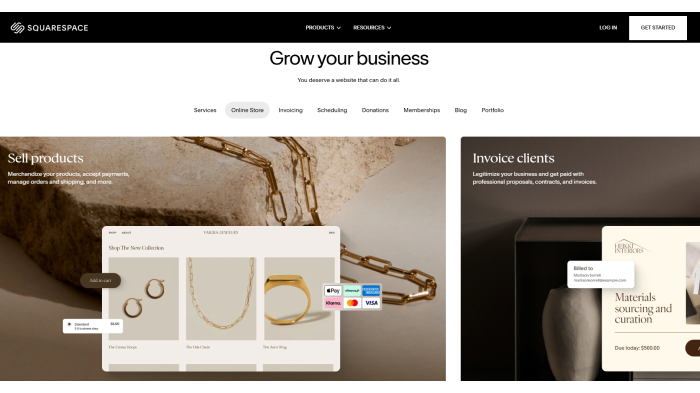
Squarespace is another design-first platform, known for its elegant templates and intuitive interface. It’s particularly attractive to artists, photographers, and personal brands selling a curated selection of products.
Pricing: Squarespace 2025 plans cost $16 (Basic), $23 (Core), $39 (Plus), and $99 (Advanced) per month, billed annually.
Perfect for artists, photographers, or small creative shops selling a handful of products online.
CalArts uses Squarespace Enterprise to help students build portfolio websites that showcase their artistic work. With user-friendly templates, e-commerce options, and SEO tools, Squarespace empowers emerging artists to control their brand, sell creations, and launch careers.
| Platform | Best For | Cost Structure | Customization | B2B Features | Multi-Store/Vendor | Compliance |
| nopCommerce | SMB → Enterprise | Free + Dev | Unlimited | Strong | Native | PCI, GDPR |
| Shopify | SMB, DTC brands | $39–$2,300/mo | Limited (apps) | Plus only | Limited | PCI, SaaS |
| WooCommerce | WordPress users | Free + Dev | Flexible | Limited | Via plugins | Plugin-dependent |
| Magento (Adobe Commerce) | Enterprises | $22k–$125k/year | Very high | Strong | With Dev work | Configurable |
| Wix | Small businesses | $17–$159/mo | Low | Weak | No | Basic |
| Squarespace | Creatives | $16–$99/mo | Low | Weak | No | Basic |
Choosing between platforms isn’t just about features — it’s about aligning with your business stage, resources, and growth goals.
The landscape of eCommerce platforms is vast, and no single solution fits everyone. By comparing features, pricing, and real-world pros and cons, you now have a clearer lens on where Shopify, WooCommerce, Magento, Wix, Squarespace, and nopCommerce stand in 2025.
If nopCommerce is on your shortlist, take a deeper look at our guide: nopCommerce E-commerce Platform: 2025 Guide to Who It’s Ideal For. It breaks down who benefits most from nopCommerce and when it becomes the smarter upgrade path.
Leave A Comment